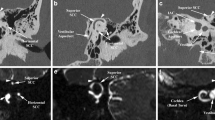Abstract
Purpose of Review
Knowledge regarding superior semicircular canal dehiscence (SSCD) is quickly evolving. There are multiple aspects of SSCD that need to be considered in the diagnosis and treatment of this entity. Knowing the outcomes from treatment, the neuro-otologist is better equipped in counseling the patient regarding prognosis and individualized best management options.
Recent Findings
Now going on nearly 20 years since its initial description in the literature, the treatment options for SSCD have expanded and the results of treatment are being reported. Unfortunately, with variations in techniques and small numbers reported, comparison of differing techniques is challenging. Since 1998, our group has performed more than 400 SSCD surgical procedures of varying types. Much of this review is colored by this experience. We will review the pathophysiology and surgical outcomes for SSCD in order to give the reader a better appreciation of prognosis for treatment.
Summary
SSCD can have multiple unique presentations, with varying degrees of symptoms. The treatment options can range from non-surgical to minimally invasive to a variety of more invasive procedures. Knowing the pathophysiology and the outcomes from intervention can aid the physician in directing the patients care most appropriately.




Similar content being viewed by others
References
Papers of particular interest, published recently, have been highlighted as: • Of importance •• Of major importance
•• Minor LB, Solomon D, Zinreich JS, Zee DS. Sound- and/or pressure-induced vertigo due to bone dehiscence of the superior semicircular canal. Arch Otolaryngol Head Neck Surg. 1998;124:249–58. Initial paper describing SSCD
Meiklejohn DA, Corrales CE, Boldt BM, Sharon JD, Yeom KW, Carey JP, et al. Pediatric semicircular canal dehiscence: radiographic and histologic prevalence, with clinical correlation. Otol Neurotol. 2015;36(8):1383–9.
•• Carey JP, Minor LB, Nager GT. Dehiscence or thinning of the bone overlying the superior semicircular canal in a temporal bone survey. Arch Otolaryngol Head Neck Surg. 2000;126(2):137–47. Largest histologic survey of SSCD among temporal bones
Davey S, Kelly-Morland C, Phillips JS, Nunney I, Pawaroo D. Assessment of superior semicircular canal thickness with advancing age. Laryngoscope. 2015;125(8):1940–5.
Noonan KY, Russo J, Shen J, Rehm H, Halbach S, Hopp E, et al. CDH23 related hearing loss: a new genetic risk factor for semicircular canal dehiscence? Otol Neurotol. 2016;37(10):1583–8.
Zhou G, Gopen Q, Poe DS. Clinical and diagnostic characterization of canal dehiscence syndrome: a great otologic mimicker. Otol Neurotol. 2007;28(7):920–6.
Tavassolie TS, Penninger RT, Zuñiga MG, Minor LB, Carey JP. Multislice computed tomography in the diagnosis of superior canal dehiscence: how much error, and how to minimize it? Otol Neurotol. 2012;33(2):215–22.
Kuhn JJ, Clenney T. The association between semicircular canal dehiscence and Chiari type I malformation. Arch Otolaryngol Head Neck Surg. 2010;136(10):1009–14.
Picavet V, Govaere E, Forton G. Superior semicircular canal dehiscence: prevalence in a population with clinical suspected otosclerosis-type hearing loss. B-ENT. 2009;5(2):83–8.
Arts HA, Adams ME, Telian SA, El-Kashlan H, Kileny PR. Reversible electrocochleographic abnormalities in superior canal dehiscence. Otol Neurotol. 2009;30(1):79–86.
Merchant SN, Rosowski JJ. Conductive hearing loss caused by third window lesions of the inner ear. Otol Neurotol. 2008;29:282–9.
Superior GG. Semicircular canal dehiscence repair. In: Babu S, editor. Practical otology for the otolaryngologist. San Diego: Plural Publishing; 2013. p. 287–96.
Wackym PA, Wood SJ, Siker DA, Carter DM. Otic capsule dehiscence syndrome: superior semicircular canal dehiscence syndrome with no radiographically visible dehiscence. Ear Nose Throat J. 2015;94(8):E8–E24.
Ward BK, Wenzel A, Ritzl EK, Gutierrez-Hernandez S, Della Santina CC, Minor LB, et al. Near-dehiscence: clinical findings in patients with thin bone over the superior semicircular canal. Otol Neurotol. 2013;34(8):1421–8.
Gianoli GJ. Deficiency of the superior semicircular canal. Curr Opin Otolaryngol Head Neck Surg. 2001;9:336–41.
• Silverstein H, Kartush JM, Parnes LS, Poe DS, Babu SC, Levenson MJ, et al. Round window reinforcement for superior semicircular canal dehiscence: a retrospective multi-center case series. Am J Otolaryngol. 2014;35(3):286–93. Muti-center study of round window occlusion
Smullen JL, Andrist EC, Gianoli GJ. Superior semicircular canal dehiscence: a new cause of vertigo. J LA State Med Soc. 1999;151:397–400.
• Gioacchini F, Alicandri-CIufelli M, Kaleci S, Scarpa A, Cassandro E, Re M. Outcomes and complications in superior semicircular canal dehiscence surgery: a systematic review. Laryngoscope. 2016;126:1218–24. Recent review of 20 outcome studies of SSCD surgery
• Ziylan F, Kinaci A, Beynon A, Kunst H. A comparison of surgical treatments for superior semicircular canal dehiscence: a systematic review. Otol Neurotol. 2017;38:1–10. Recent review of 59 outcome studies of SSCD surgery
Author information
Authors and Affiliations
Corresponding author
Ethics declarations
Conflict of Interest
Dr. Gerard J. Gianoli and Dr. James S. Soileau declare that they have no conflicts of interest.
Human and Animal Rights and Informed Consent
This article does not contain any studies with human or animal subjects performed by any of the authors.
Additional information
This article is part of the Topical Collection on Otology: Vestibular Disorders
Rights and permissions
About this article
Cite this article
Gianoli, G.J., Soileau, J.S. Superior Semicircular Canal Dehiscence: Pathophysiology and Surgical Outcomes. Curr Otorhinolaryngol Rep 5, 153–159 (2017). https://doi.org/10.1007/s40136-017-0156-2
Published:
Issue Date:
DOI: https://doi.org/10.1007/s40136-017-0156-2




